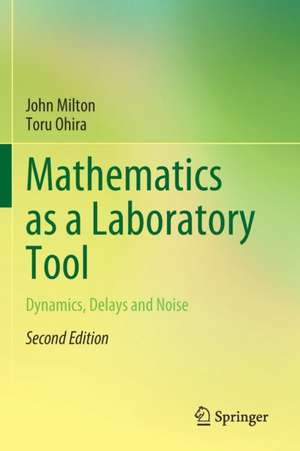Mathematics as a Laboratory Tool: Dynamics, Delays and Noise
Autor John Milton, Toru Ohiraen Limba Engleză Paperback – 13 aug 2022
The second edition of Mathematics as a Laboratory Tool reflects the growing impact that computational science is having on the career choices made by undergraduate science and engineering students. The focus is on dynamics and the effects of time delays and stochastic perturbations (“noise”) on the regulation provided by feedback control systems. The concepts are illustrated with applications to gene regulatory networks, motor control, neuroscience and population biology. The presentation in the first edition has been extended to include discussions of neuronal excitability and bursting, multistability, microchaos, Bayesian inference, second-order delay differential equations, and the semi-discretization method for the numerical integration of delay differential equations.
Every effort has been made to ensure that the material is accessible to those with a background in calculus. The text provides advanced mathematical concepts such as the Laplace and Fourier integral transforms in the form of Tools. Bayesian inference is introduced using a number of detective-type scenarios including the Monty Hall problem.
| Toate formatele și edițiile | Preț | Express |
|---|---|---|
| Paperback (2) | 434.62 lei 6-8 săpt. | |
| Springer – 23 aug 2016 | 434.62 lei 6-8 săpt. | |
| Springer International Publishing – 13 aug 2022 | 475.70 lei 6-8 săpt. | |
| Hardback (1) | 487.71 lei 38-45 zile | |
| Springer International Publishing – 12 aug 2021 | 487.71 lei 38-45 zile |
Preț: 475.70 lei
Nou
Puncte Express: 714
Preț estimativ în valută:
91.03€ • 95.16$ • 76.93£
91.03€ • 95.16$ • 76.93£
Carte tipărită la comandă
Livrare economică 07-21 martie
Preluare comenzi: 021 569.72.76
Specificații
ISBN-13: 9783030695811
ISBN-10: 3030695816
Pagini: 638
Ilustrații: XXV, 638 p. 210 illus., 8 illus. in color.
Dimensiuni: 155 x 235 mm
Greutate: 0.92 kg
Ediția:2nd ed. 2021
Editura: Springer International Publishing
Colecția Springer
Locul publicării:Cham, Switzerland
ISBN-10: 3030695816
Pagini: 638
Ilustrații: XXV, 638 p. 210 illus., 8 illus. in color.
Dimensiuni: 155 x 235 mm
Greutate: 0.92 kg
Ediția:2nd ed. 2021
Editura: Springer International Publishing
Colecția Springer
Locul publicării:Cham, Switzerland
Cuprins
Science and the Mathematics of Black Boxes.- The Mathematics of Change.- Equilibria and Steady States.- Stability.- Fixed Points: Creation and Destruction.- Transient Dynamics.- Frequency Domain I: Bode Plots and Transfer Functions.- Frequency Doman II: Fourier Analysis and Power Spectra.- Feedback and Control Systems-. Time delays.- Oscillations.- Characterizing and Manipulating Oscillations.- Beyond Limit Cycles.- Random Perturbations.- Noisy Dynamical Systems.- Random Walks.- Thermodynamic Perspectives.- Concluding Remarks.
Notă biografică
John Milton, Professor of Biology and William R. Kenan Jr Chair n Computational Neuroscience, The Claremont Colleges; Adjunct Professor of Biotechnology, Keck Graduate Institute
Toru Ohira, Professor Mathematics, Graduate School of Mathematics, Nagoya University, Japan
Textul de pe ultima copertă
The second edition of Mathematics as a Laboratory Tool reflects the growing impact that computational science is having on the career choices made by undergraduate science and engineering students. The focus is on dynamics and the effects of time delays and stochastic perturbations (“noise”) on the regulation provided by feedback control systems. The concepts are illustrated with applications to gene regulatory networks, motor control, neuroscience and population biology. The presentation in the first edition has been extended to include discussions of neuronal excitability and bursting, multistability, microchaos, Bayesian inference, second-order delay differential equations, and the semi-discretization method for the numerical integration of delay differential equations.
Every effort has been made to ensure that the material is accessible to those with a background in calculus. The text provides advanced mathematical concepts such as the Laplace and Fourier integral transforms in the form of Tools. Bayesian inference is introduced using a number of detective-type scenarios including the Monty Hall problem.
"Based on the authors' experience teaching biology students, this book introduces a wide range of mathematical techniques in a lively and engaging style. Examples drawn from the authors' experimental and neurological studies provide a rich source of material for computer laboratories that solidify the concepts. The book will be an invaluable resource for biology students and scientists interested in practical applications of mathematics to analyze mechanisms of complex biological rhythms."
(Leon Glass, McGill University, 2013)
Every effort has been made to ensure that the material is accessible to those with a background in calculus. The text provides advanced mathematical concepts such as the Laplace and Fourier integral transforms in the form of Tools. Bayesian inference is introduced using a number of detective-type scenarios including the Monty Hall problem.
Review:
Caracteristici
Presents mathematical theory to non-mathematicians Includes exercises and chapter-level Q&A Applies laboratory methodology and incorporates real laboratory exercises as supplementary material Progresses in concept complexity from introductory to advanced
Recenzii
“This book, written in an engaging and intuitivestyle, is aimed at undergraduate biology students; its primary goal is toprovide a clear, comprehensive overview of the appropriate mathematicalinstruments for data collection and analysis, both deterministic andstochastic. … the book also has the stated goal of contributing to a bettershaping of the curricula for undergraduate biology education towards a bettercoverage of analytic, mathematical and computational methods.” (Paul Georgescu,zbMATH 1319.92001, 2015)
